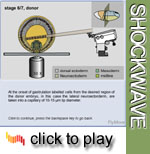Cell transplantation
Why transplant
cells ?
Cell transplantation is a powerful tool for studying cell fate determination
during development. It allows the study of cells of known origin in various
kinds of environments. Thus, cell transplantation can be used to address
several types of questions. For example:
- Isotopic and isochronic transplantation of precursor cells (same position
and stage in donor and host) has been used to study their normal fate
(see
also DiI
labelling technique).
- Heterotopic transplantation of cells (different positions in donor
and host) adresses their regional determination and their ability to
communicate with the surrounding tissue.
- Heterochronic
transplantation (different developmental stage of donor and host) allows
testing for the reversibility of the determination of the transplanted
cells or for the time period in which particular cell communication
processes are active.
- Using heterogenetic transplantations (transplantation of mutant cells
into wild-type hosts or vice versa) it is possible to test for the cell-autonomous
versus non-autonomous requirements of a gene.
- Interspecific transplantations of cells (between different species)
can be used to study the functional compatibility, i.e. evolutionary
conservation of mechanisms that involve intercellular communication.
- Finally, transplantation of pole cells can be used for the generation of germ line clones (e.g. in order to test the role of the maternal contribution of a particular gene).
How to transplant cells
In order to identify the transplanted cells after the transplantation
experiment, individual cells are usually transplanted from labelled donors
into unlabelled hosts (postblastodermal stages).  Labelling
of donors can be achieved by the injection of cell lineage markers (like
HRP or Fluorescent dyes) at the syncytial blastoderm stage. The tracer
is incorporated into all cells during cellularization. Alternatively,
or in addition, donors can be labelled by genetic markers. Upon cellularization
(from stage 7 onwards) cells can be removed from particular positions
of donors and singly transplanted into a particular position of the host.
During further development of the host the entire cell lineage originating
from the transplanted precursor is detectable by the marker (being exclusively
transferred to the progeny of the transplanted cells) and the clonal phenotype
can be analysed in permanent preparations. The method can also be used
for the transplantation of genetically labelled nuclei (mosaic analysis).
Labelling
of donors can be achieved by the injection of cell lineage markers (like
HRP or Fluorescent dyes) at the syncytial blastoderm stage. The tracer
is incorporated into all cells during cellularization. Alternatively,
or in addition, donors can be labelled by genetic markers. Upon cellularization
(from stage 7 onwards) cells can be removed from particular positions
of donors and singly transplanted into a particular position of the host.
During further development of the host the entire cell lineage originating
from the transplanted precursor is detectable by the marker (being exclusively
transferred to the progeny of the transplanted cells) and the clonal phenotype
can be analysed in permanent preparations. The method can also be used
for the transplantation of genetically labelled nuclei (mosaic analysis).
Prerequisites for applying this approach
- Fate maps are required to identify the anlagen from/into which cells are transplanted. For example, a detailed fate map exists for the early gastrula stage. The wildtype lineages of the various types of progenitor cells must be known in order to be able to detect and interpret phenotypic changes resulting from the respective experimental manipulation (exposure to a different spatial, temporal or genetic environment). Detailed descriptions of the wildtype lineages exist for precursors from all germ layers, and in particular for the entire set of neuroblasts forming the ventral nerve cord (Interactive Neuroblasts).
- Equipment: Inverted microscope (equipped with Nomarski optics and
epifluorescence); micromanipulator; electrode puller; capillary tip
grinder

Media list